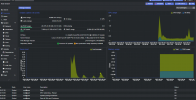Hi everyone!
First: Why?
Well, a low power node to run the network's essentials is never a bad thing, and I didn't wanted to go for a RaspberryPI, because it's both expensive for what it is at the moment due to shortages, and also because I prefer to reduce the number of different environments I'm running, just for cohesion.
Though, as a piece of tech from 2017, it sure needed fresh thermal paste. Thankfully, they are quite easy to open and clean. 1 screw under the back sticker, clips all around, 4 screws on the cooler (1 on the back of the board into the cooler, 3 from the front into the chassis), and the fan is just clipped in the removed pannel.
Two: How?
Well sure, the compute stick only have wifi and bluetooth, and rely on proprietary blobs I can't (or am too lazy to) find.
To not help with it, Proxmox's installer just craps itself when trying to create partitions, can't find the MMC storage (though in the device selection, it does find it).
The solution has been to just install a bog standard debian bullseye: go with the net install, enjoy the fancy graphical install, and during installation, just uncheck all desktop environment components when prompted about it. You just installed debian with just CLI. Perfect.
For networking, well, the STK2M3W64CC 's wall-wart has 2 USB 3.0, the stick itself has 1. You know, Amazon basic usb-RJ45 adapters are cheap?
Yes, that's how. 2 of them will do wonders to have a main lan interface + a dedicated pve-cluster (and k3s cluster) communication interface, directly at the wall.
Just plugged a keyboard in the USB port on the stick to be able to go through the install.
From there, editing /etc/hosts and /etc/hostname ... then /etc/network/interfaces to go make the base network config.
Then just following the official install protocol for Proxmox VE 7.x on Debian Bullseye.
And it works just fine!

It went overall pretty smoothly, as soon as I decided to ditch the PVE ISO and to go the bog-standard-debian route then manual install, so just know that YES proxmox can run on a compute stick, but you have to manually do the install afaik.
PS: Have been running amazon basic usb lan adapters for a few nodes for more than a year, and they proved themselves quite reliable. Months of uptime, no drop, no wonkiness. If you have some thinclients as nodes and you are sad they go neither a PCI-e lowprofile slot nor a second(or primary) ethernet port, these adapters are doing just fine most of the time.
First: Why?
Well, a low power node to run the network's essentials is never a bad thing, and I didn't wanted to go for a RaspberryPI, because it's both expensive for what it is at the moment due to shortages, and also because I prefer to reduce the number of different environments I'm running, just for cohesion.
Though, as a piece of tech from 2017, it sure needed fresh thermal paste. Thankfully, they are quite easy to open and clean. 1 screw under the back sticker, clips all around, 4 screws on the cooler (1 on the back of the board into the cooler, 3 from the front into the chassis), and the fan is just clipped in the removed pannel.
Two: How?
Well sure, the compute stick only have wifi and bluetooth, and rely on proprietary blobs I can't (or am too lazy to) find.
To not help with it, Proxmox's installer just craps itself when trying to create partitions, can't find the MMC storage (though in the device selection, it does find it).
The solution has been to just install a bog standard debian bullseye: go with the net install, enjoy the fancy graphical install, and during installation, just uncheck all desktop environment components when prompted about it. You just installed debian with just CLI. Perfect.
For networking, well, the STK2M3W64CC 's wall-wart has 2 USB 3.0, the stick itself has 1. You know, Amazon basic usb-RJ45 adapters are cheap?
Yes, that's how. 2 of them will do wonders to have a main lan interface + a dedicated pve-cluster (and k3s cluster) communication interface, directly at the wall.
Just plugged a keyboard in the USB port on the stick to be able to go through the install.
From there, editing /etc/hosts and /etc/hostname ... then /etc/network/interfaces to go make the base network config.
Then just following the official install protocol for Proxmox VE 7.x on Debian Bullseye.
And it works just fine!

It went overall pretty smoothly, as soon as I decided to ditch the PVE ISO and to go the bog-standard-debian route then manual install, so just know that YES proxmox can run on a compute stick, but you have to manually do the install afaik.
PS: Have been running amazon basic usb lan adapters for a few nodes for more than a year, and they proved themselves quite reliable. Months of uptime, no drop, no wonkiness. If you have some thinclients as nodes and you are sad they go neither a PCI-e lowprofile slot nor a second(or primary) ethernet port, these adapters are doing just fine most of the time.
Last edited:


